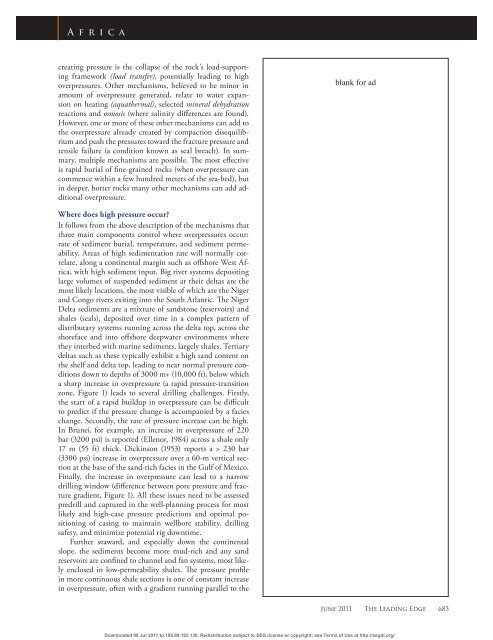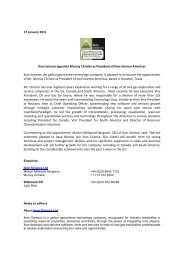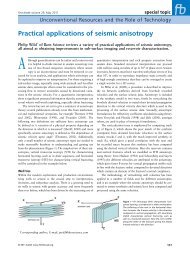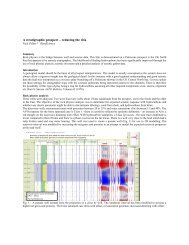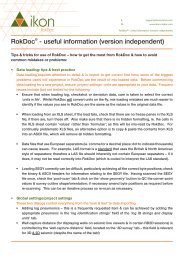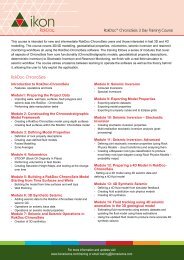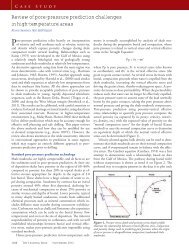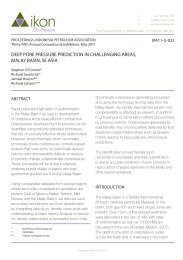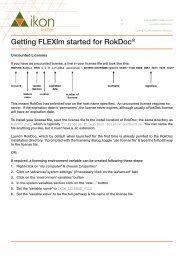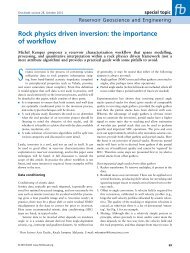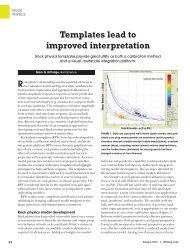Downloaded - Ikon Science
Downloaded - Ikon Science
Downloaded - Ikon Science
You also want an ePaper? Increase the reach of your titles
YUMPU automatically turns print PDFs into web optimized ePapers that Google loves.
Africa<br />
creating pressure is the collapse of the rock’s load-supporting<br />
framework (load transfer), potentially leading to high<br />
overpressures. Other mechanisms, believed to be minor in<br />
amount of overpressure generated, relate to water expansion<br />
on heating (aquathermal), selected mineral dehydration<br />
reactions and osmosis (where salinity differences are found).<br />
However, one or more of these other mechanisms can add to<br />
the overpressure already created by compaction disequilibrium<br />
and push the pressures toward the fracture pressure and<br />
tensile failure (a condition known as seal breach). In summary,<br />
multiple mechanisms are possible. The most effective<br />
is rapid burial of fine-grained rocks (when overpressure can<br />
commence within a few hundred meters of the sea-bed), but<br />
in deeper, hotter rocks many other mechanisms can add additional<br />
overpressure.<br />
<br />
Where does high pressure occur?<br />
It follows from the above description of the mechanisms that<br />
three main components control where overpressures occur:<br />
rate of sediment burial, temperature, and sediment permeability.<br />
Areas of high sedimentation rate will normally correlate,<br />
along a continental margin such as offshore West Africa,<br />
with high sediment input. Big river systems depositing<br />
large volumes of suspended sediment at their deltas are the<br />
most likely locations, the most visible of which are the Niger<br />
and Congo rivers exiting into the South Atlantic. The Niger<br />
Delta sediments are a mixture of sandstone (reservoirs) and<br />
shales (seals), deposited over time in a complex pattern of<br />
distributary systems running across the delta top, across the<br />
shoreface and into offshore deepwater environments where<br />
they interbed with marine sediments, largely shales. Tertiary<br />
deltas such as these typically exhibit a high sand content on<br />
the shelf and delta top, leading to near normal pressure conditions<br />
down to depths of 3000 m+ (10,000 ft), below which<br />
a sharp increase in overpressure (a rapid pressure-transition<br />
zone, Figure 1) leads to several drilling challenges. Firstly,<br />
the start of a rapid buildup in overpressure can be difficult<br />
to predict if the pressure change is accompanied by a facies<br />
change. Secondly, the rate of pressure increase can be high.<br />
In Brunei, for example, an increase in overpressure of 220<br />
bar (3200 psi) is reported (Ellenor, 1984) across a shale only<br />
17 m (55 ft) thick. Dickinson (1953) reports a > 230 bar<br />
(3300 psi) increase in overpressure over a 60-m vertical section<br />
at the base of the sand-rich facies in the Gulf of Mexico.<br />
Finally, the increase in overpressure can lead to a narrow<br />
drilling window (difference between pore pressure and fracture<br />
gradient, Figure 1). All these issues need to be assessed<br />
predrill and captured in the well-planning process for most<br />
likely and high-case pressure predictions and optimal positioning<br />
of casing to maintain wellbore stability, drilling<br />
safety, and minimize potential rig downtime.<br />
Further seaward, and especially down the continental<br />
slope, the sediments become more mud-rich and any sand<br />
reservoirs are confined to channel and fan systems, most likely<br />
enclosed in low-permeability shales. The pressure profile<br />
in more continuous shale sections is one of constant increase<br />
in overpressure, often with a gradient running parallel to the<br />
June 2011 The Leading Edge 683<br />
<strong>Downloaded</strong> 08 Jul 2011 to 195.99.165.130. Redistribution subject to SEG license or copyright; see Terms of Use at http://segdl.org/


